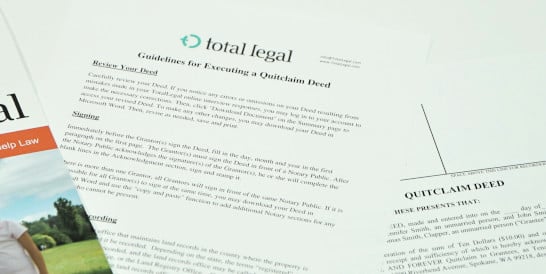Quitclaim and Warranty Deeds Compared

A deed is a legal document that transfers rights to real estate from one or more people or entities (trust, LLC, corporation, etc.) to another. The two most common types of deeds are quitclaim deeds and warranty deeds. While both types transfer property rights, only the warranty deed includes additional promises about the land, namely that the grantor (owner) will be responsible for legal costs if anyone sues the grantee (buyer) claiming to have rights to it.
QUITCLAIM DEED
With a quitclaim deed, the grantor, doesn't make any promises about the property to the grantee other than the transfer of all of grantor's interest in the property. In effect, the grantor "quits" any claim to the property listed in the deed.
Common Uses for quitclaim Deeds
Quitclaim deeds are used for a variety of transactions, including:
- In divorce to transfer one spouse's property interest to the other. In a deed used for this purpose, both spouses of the jointly held real estate are listed as grantors, but only the spouse receiving the property is listed as the grantee.
- In an exchange between family members/acquainted parties when little or no money or other valuable consideration is being paid for the property.
Adding Someone to the Deed
Sometimes a property owner will want to add another person to the deed to give them a legal interest in the property. A common example is when someone owns real estate and wants to use a quitclaim deed to add a spouse or significant other to the deed without refinancing. In this case, the quitclaim deed lists the grantor as both grantor and grantee. The person being added is also listed as a grantee. This secures the grantor's existing ownership rights in the property and also makes the grantee an owner to the same extent as the grantor.
However, if the property is secured by a mortgage or other instrument of indebtedness, proceed with caution because those documents routinely include a clause that triggers default on the loan if any interest in the property is transferred to another person. This means the bank could require the mortgage to be paid in full immediately or foreclose on the property. If you aren't sure if your mortgage prohibits you from transferring ownership rights in the property to anyone else, contact your lender(s) before doing anything. The same is true with warranty deeds.
WARRANTY DEEDS
With a warranty deed, the seller does make promises (also known as warranties) about the title to the property and possibly about the condition as well, depending on the transaction. The warranty deed transfers the grantor's interest in the property to the buyer, just like a quitclaim deed, but also makes the grantor liable for any property interest claims anyone else might make in the future. A warranty deed can also be used hold the grantor liable for damages if the property is not usable for the intended purpose of the grantee. A warranty deed is common in commercial transactions like sales between non-familial, unfamiliar parties.
PREPARING YOUR DEED
Once you've decided on the right type of deed for you, you can prepare your own deed using an online legal forms website like TotalLegal.com. It's very helpful to have a recorded copy of the last deed for the property with you when you prepare the new deed because it lists the legal description of the property as well as other prior deed information (ex. book/volume, page # where the last deed on the property was recorded) that is needed in some states. The legal description is always the same and should be identical to the property description listed on any prior deeds to the party unless the property was legally partitioned into smaller parcels. The new deed must list the physical address of the property and of the parties involved in the exchange and list the sale price, if any, which is also referred to as "consideration."
You may also need to enter the tax/parcel ID number for the property, the address where tax statements should be sent and the person to whom the deed should be returned after recording, if it was filed with the recorder's office by mail instead of in person.
SIGNING, FILING/RECORDING AND TAXES
After the deed is prepared, all grantors need to sign the deed in front of a Notary Public. They don't have to sign at the same time or even in the same state, but all must sign before the deed is considered valid. Then, the deed is filed at the land records office in the county where the property is located. The clerk will collect a small fee for recording the deed. Recording is when the deed will be assigned its unique place in the land records for the county—book/volume, page, etc. This will be a different location than any prior deeds to the property.
Depending on the county and whether the transfer is exempt from transfer tax under the laws where the property is located, there may also be a transfer tax form and a tax on the transfer. Also, as the new owners, the grantees are responsible for paying the property taxes associated with the real estate.